Bean plants don’t demand that much when it comes to fertilization requirements. This is because they are legumes and they mainly fix nutrients like nitrogen. So, they are capable of providing some of their nitrogen generally. So, you may just need a 3-to-4-inch layer of work in compost. However, if you have less fertile soil your Green Bean plant may not flourish well. Let’s check out best fertilizer for Green Beans.
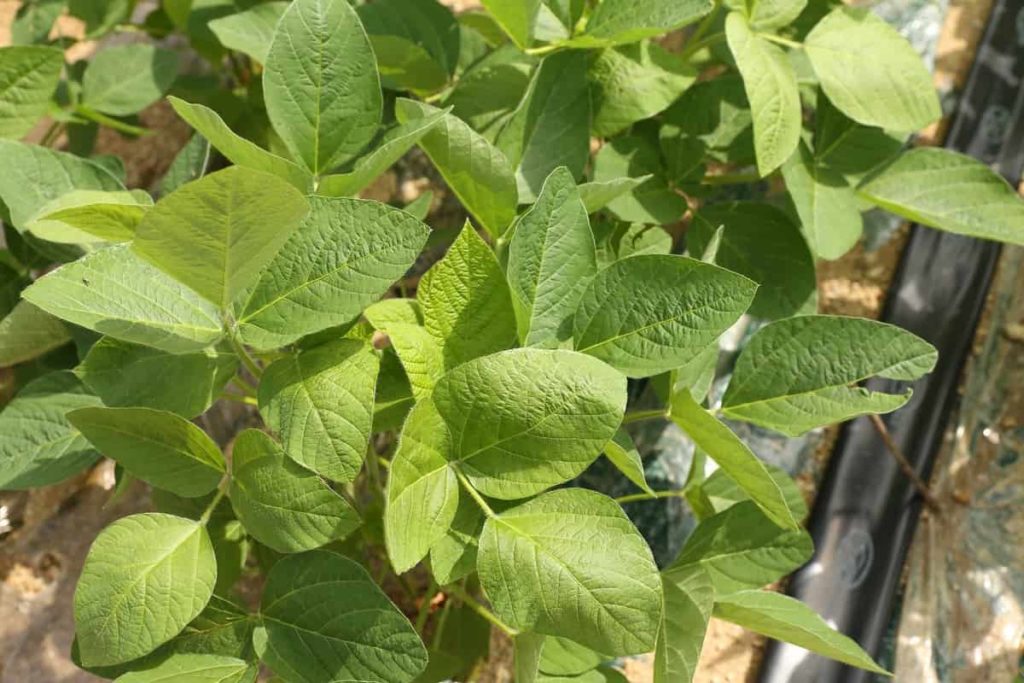
When it comes to the growth of the plant, any gardener will think of the first nitrogen fertilizer. However, when it comes to legumes like Beans, these plants are nitrogen fixers. Therefore, they are capable of fixing nitrogen in the soil and this nitrogen is obtained from the air. So, avoid supplying your Green Beans with nitrogen-rich fertilizer as it can harm your plant. Excess nitrogen can result in the growth of extra stems and leaves and maybe offered little or small Beans.
Phosphorus is an essential nutrient for Bean plants need to develop a good root system to a large extent. But as we have mentioned before, Beans do not require heavy nutrients. Therefore, you can only use 3-inch layers of fertilizer to enhance the growth of your Green Bean plant. Potassium is another nutrient that can help Green Beans grow effectively. It is like a supportive nutrient in the growth of the Beans.
While potassium does not present any major impact on growth like stem or nitrogen and phosphorus, potassium will still help keep the Beans healthy. So, this will encourage or support the growth of Green Beans. In addition to nitrogen, phosphorus, and potassium, Beans also require small amounts of calcium, manganese, and iron. Your soil probably contains a fair amount of these nutrients, especially if you modify it annually with compost or manure.
In case you miss this: Beans Planting Frequently Asked Questions (FAQs)

Best fertilizer for Green Beans
Compost manure for Green Beans
Well-rotten manure
Well-rotten compost is more suitable. This not only includes important nutrients for your Beans but also ensures better soil structure and active soil life.
Compost
Compost is a good soil modification for the proper growth of Bean plants, as it improves soil structure while providing a light quantity of macronutrients like nitrogen.
Chicken Manure
If you are planting Green Beans in containers, mix 1-2 tablespoons alfalfa meal or composted chicken manure per gallon of potting soil when you plant. Horse, cow, or sheep manure is helpful as these fertilizers are low in nitrogen. Wide Beans make their nitrogen so all efforts are made to avoid the use of fertilizers that are high in nitrogen, such as chook manure and fish emulation. Cured compost and aged animal manure contain the same nutrients found in chemical fertilizers.
Although they work more slowly than chemical fertilizers, they provide their benefits more regularly and stably and improve soil structure. Cured compost or aged animal manure can be added to the soil at the time of planting or the day before planting. Use one of these for every 100 square feet of soil at a rate of 1.4 to 1.8 kg, 100 feet of plant row in the future or an area that is 10 feet by 10 feet wide in length, and work it up to a depth of about 6 inches in the soil.
In case you miss this: Tips For Growing Beans, Ideas, Tricks, Secrets
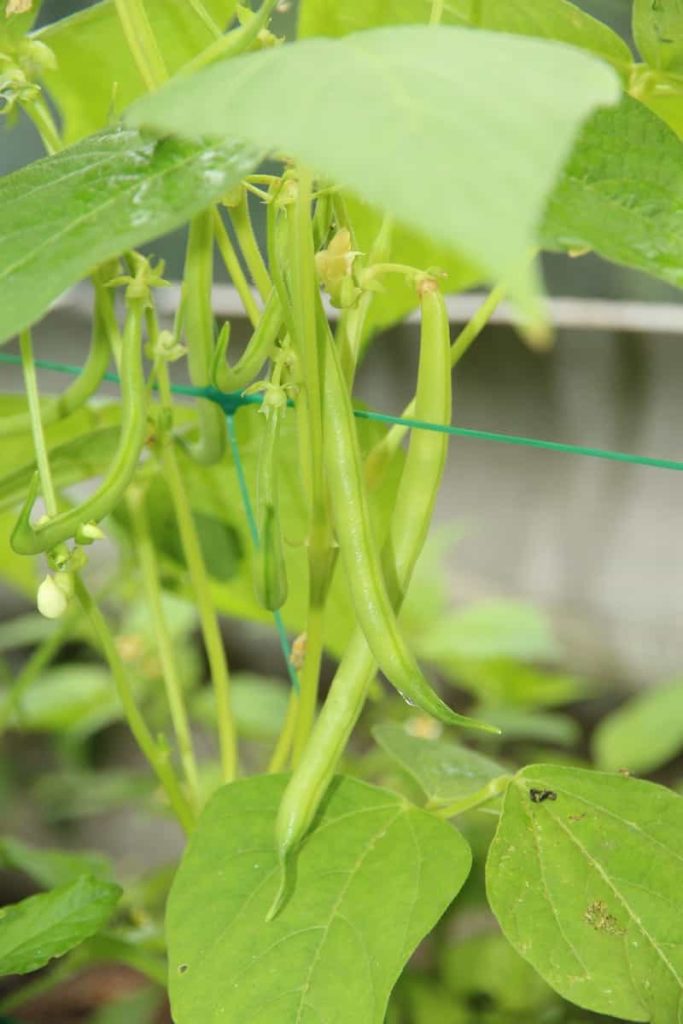
Organic fertilizers for Green Beans
Bone meal
Phosphorus helps the root system of the Bean plant grow. For a light dose of nutrients, add 450 grams of bone meal per 100 square feet.
Greensand
Potassium primarily helps when it comes to the growth of the Bean plant. Add 4.5 kg of ground granite or 4.5 kg of green sand per 100 square feet.
Blood meal
Blood meal also affects the growth of the Bean plant. Organic options include blood meals added at the rate of 450 grams per 100 square feet for light food.
Homemade and liquid fertilizers for Gren Beans
Wood ash
Peas and Beans (Beans are a better weight and color) and fruits all appreciate potash. Use it, especially around peas and Beans, and soft fruit bushes.
Compost tea
Compost tea can help plants grow faster, increase productivity and improve their overall health, reducing the number of insects and diseases.
Fish emulsion
Once established, Beans will not normally need fertilizing and will produce their nitrogen. However, if the leaves of young plants are yellow, it is indicative of a lack of nitrogen and the initiators can be fertilized with fish emulsion or other natural nitrogen-rich manure.
Natural fertilizers for Green Beans
- Straw or wood chips are the best mulch materials you can use around your vegetable plants. It’s clean, it’s light, and it breaks relatively easily, giving your plants more than they need to grow.
- If you prefer, you can use a flat cardboard box, or you can use a cereal box, like a paperboard box. Cut it, make it nice and flat, and place it on the ground in the middle. It is called sheet mulching. You can leave the paper there, and it will break. This will not add anything bad to your soil. And it will also stop the weeds, and keep that moisture in.
In case you miss this: Growing Pole Beans At Home – A Planting Guide
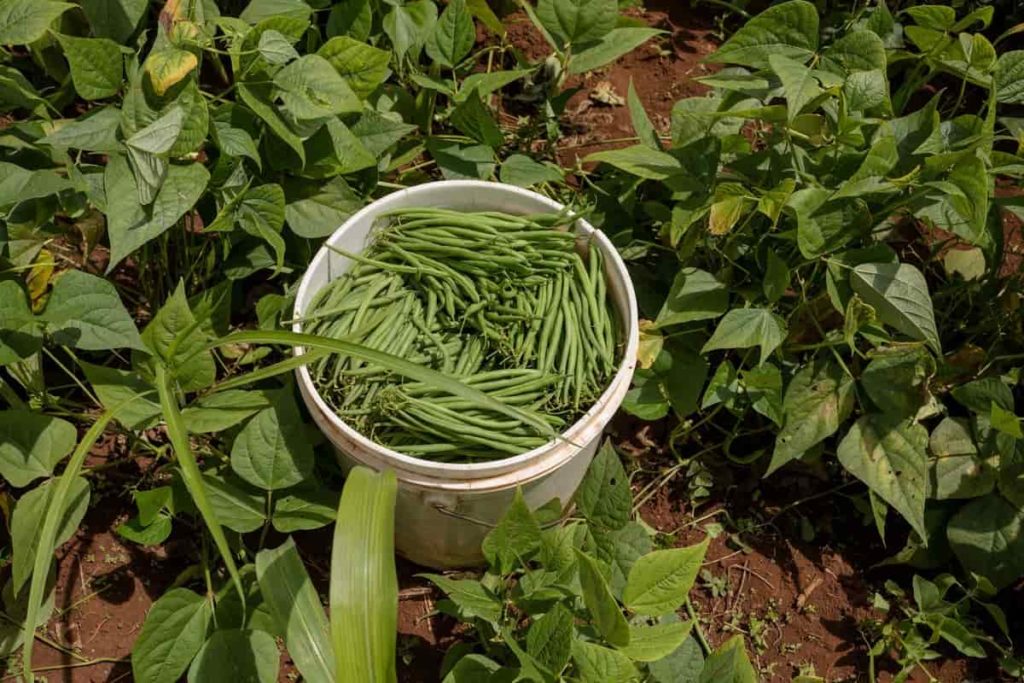
Commercial fertilizer for Green Beans
NPK ratio
The numbers on fertilizer bags indicate by weight what percentage of each of the three most important nutrients nitrogen, phosphorus, and potassium are present in the mixture. Even though the percentages may vary, the order is always the same N, P, and K. For example, 5-10-10, which is good for Beans, shows that fertilizer contains 5% nitrogen, 10% phosphorus, and 10% potassium.
Nitrogen promotes healthy green leaves and stems. If you have too much nitrogen, the plant will spend more time making leaves and less time making Beans. Phosphorus promotes strong roots and potassium gives conditions to the entire plant, which will help it to bear fruit and resist disease. 1.4 to 1.8 kg of commercial fertilizer is enough for most garden soils, such as 5-10-10 per 100 square feet, or use equal amounts of non-chemical fertilizers, such as well-rotten fertilizer, compost, bone meal, and cottonseed meal.
Green Beans fertilizer schedule
Beans can be grown outside as well as in greenhouses or pots. When planting Beans, you should ensure that the soil is rich in enough nutrients. At a point with poor soil, you can enrich the soil with manure or fertilizer with long-term organic effects before planting. Bush Beans and Field Beans no longer need fertilization later. Nitrogen-fixing bacteria are active and provide nutrients to plants. It looks different with runner Beans.
They are looking forward to additional fertilizers during the growing season. You can re-fertilize with the first flowering. If necessary, it is re-fertilized until the harvest. From the middle of May, you can plant frost-sensitive Beans in the garden bed. Even if French Beans and Field Beans need some nutrients, basic fertilization is part of it before planting. It is extremely important for Runner Beans. To be able to fix nitrogen very well, nodule bacteria need enough phosphorus.
It is provided by basic fertilization while planting in the garden. So, before planting Beans prepare the soil well. Put some fertilizer in the grainy form in the planting hole, and don’t forget to give it enough water. You can also add a little compost to poorly structured soils. These natural fertilizers not only provide valuable nutrients to your Beans but also help in improving soil structure and thus help in soil water retention capacity and heat storage.
From now on, Field and French Beans need no further fertilization. Re-fertilize the Running Beans after flowering. In terms of requirements, Runner Beans can be provided with a small quantity of fertilizer after about six to eight weeks.
In case you miss this: Growing Bush Beans In Pots – Indoors, Terrace, Balcony
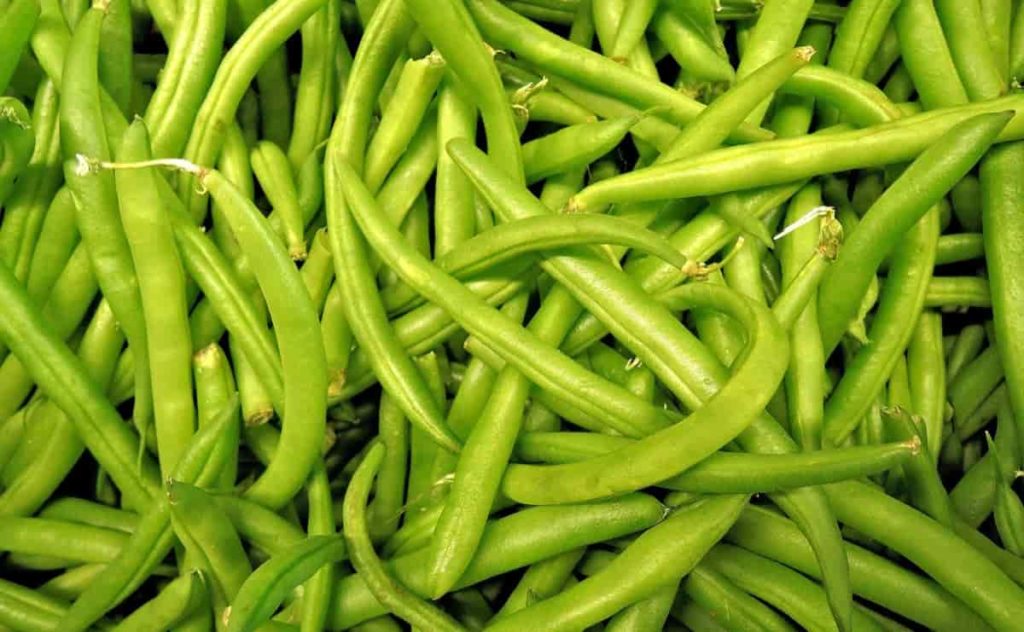
How to fertilize Green Beans in pots
If the substrate you use in a pot or balcony box is not already fertilized, it makes sense to enrich the substrate with nutrients before planting or sowing. To do this, work a long-term compost in granule forms in the substrate. After planting or sowing, water the substrate well so that the plants can grow well and the grains can dissolve.
Even in pots also French Beans and Field Beans both are satisfied with basic fertilization and grow very well even without further administration. Like a bed, runner Beans want to put fertilizer in the pot during the growing season. You can apply the first application after flowering. Depending on what type of fertilizer you choose, fertilization intervals vary. With mineral liquid fertilizer, the intervals are low and should be re-fertilized every three to five weeks.
Fertilizing tips to increase Green Beans yield
- Avoid planting Beans in alkaline soil as they will deprive the plant of nutrients in the soil.
- Avoid over-fertilizing the plant early in the growing season as it prevents it from producing blooms as well as producing Beans.
- If your Bean plant growth has stopped and new leaves are turning yellow, your soil is deficient in zinc. Fix this problem with zinc solution immediately.
- When the Beans start producing in the plant, fertilize with potassium-rich fertilizer.
- Beans are fast growers, so adding too much plant food can slow growth rates.
Commonly asked questions for fertilizers for Green Beans
Why is my Green Beans dying?
Green Beans require an adequate amount of nutrients to grow. One will be a stopping or dying plant due to too much or very little of a particular nutrient.
In case you miss this: Growing Lima Beans In Pots – A Planting Guide
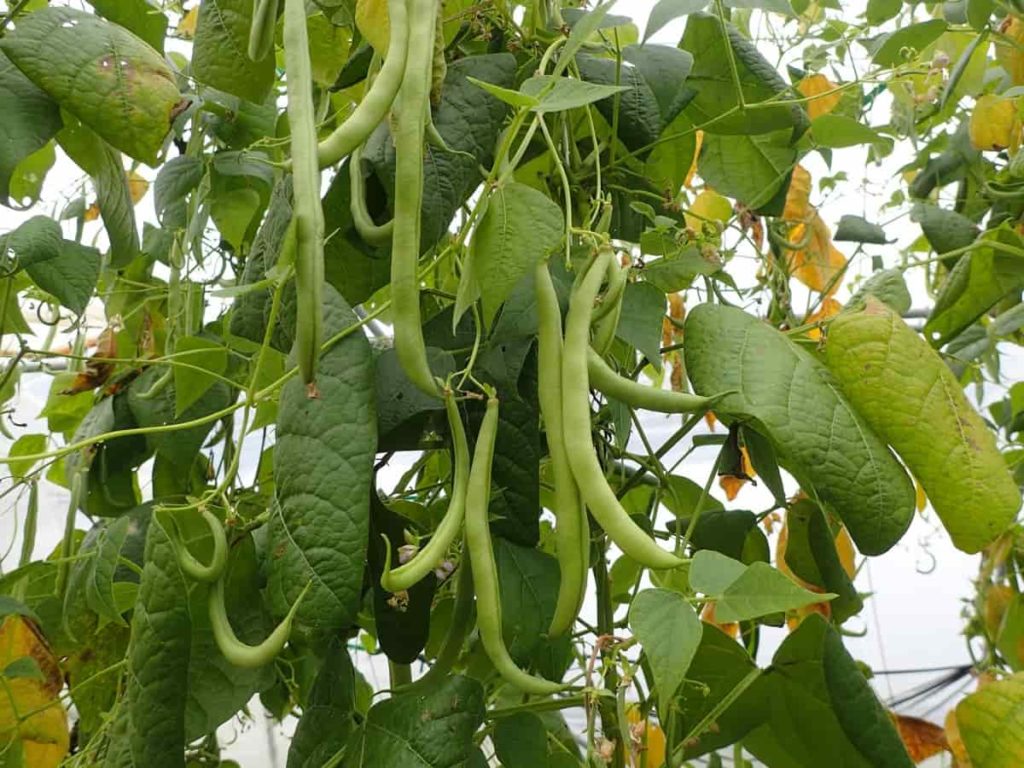
Is tomato food good for runner Beans?
You need to regularly add extra potassium to get good production of Runner Beans, and other fruit crops from containers. The easiest way to do this is to buy a bottle of tomato feed, it will work for all fruity crops. However, more potassium (potash) content will promote loads of more flowers and, most importantly, beautiful Beans.
What does nitrogen do for Beans?
Beans grow in a mutual relationship with soil-dwelling bacteria. Bacteria take gassy nitrogen from the air in the ground and feed this nitrogen to the Beans in return the plant provides carbohydrates to the bacteria.
Is DAP good for Beans?
DAP is very important to apply during plantations. The application of DAP fertilizer significantly increased the grain yields in bush and climbing Beans. These fertilizers provide suitable nutrients which are required for the proper growth and development of the crop at this stage.
Are Green Beans like lime?
The vegetables happiest when adding lime to your garden soil include Beans, cabbage, peas, spinach, other leafy vegetables. Lime provides essential calcium and magnesium in the soil.
- How to Grow Hibiscus from Flower
- Plantation Ideas for Home Decoration: A Beginners Guide
- Flower Garden Designs and Layouts for Beginners
- Planting and Spacing Techniques in Papaya: A Beginner’s Guide
- Growing Gold: Essential Techniques for Planting Pineapples
- How to Make Kalanchoe Plant Bushy: Home Remedies and Solutions
- 11 Reasons Why Your Gardenia is Not Blooming: Home Remedies and Solutions
- Eco Elegance: The Guide to Designing a Drought-Tolerant Landscape
- Gardening on a Slope: Strategies for Hillside Landscaping
- Nourish and Flourish: Top Organic Mulches for Thriving House Plants
- Everything You Want to Know about Indian Mogra Flower: Discover Uses and Growing
- Green Thumb Success: Expert Tips for Cultivating Greenhouse Pumpkins All Year Round
- Maximize Growth & Flavor: The Ultimate Guide to Companion Planting in Herb Gardens
- How to Control Rhododendron Problems Naturally: Home Remedies and Organic Ways to Fix Them
- Natural Magic: The Remarkable Benefits of Cinnamon for Plants
- Best Steps to Revive Dying Tulip with Natural and Organic Treatment
- 10 Reasons Why Your Angel Trumpet is Not Blooming: Remedies and Treatment
- How to Fix Periwinkle Leaf and Flower-Related Problems: Natural Remedies and Solutions
- How to Fix Zinnias Leaf and Flower Problems: Discover Natural and Home Remedies
- Organic Steps to Induce Lemon Tree Flowers: A Comprehensive Guide
- Bloom Booster: Crafting the Perfect Homemade Bougainvillea Fertilizer
- Optimizing Growth: A Guide to Applying NPK Fertilizer for Potted Plants
- 10 Best Homemade Fertilizers for Rubber Plant: DIY Recipes and Application Method
- How to Boost Female Pumpkin Flowers: Effective Steps for More Flowers and High Yields
- Transform Your Indoor Garden: Top Benefits of Pink Salt for Houseplants
- 10 Best Homemade Fertilizers for Peacock Plants (Calathea): Easy DIY Guide
- Unlock Blooms: 9 Reasons Why Your Potted Chrysanthemum is Not Blooming
- 8 Reasons Why Your Potted Hibiscus is Not Blooming: Fix it with Simple Solutions
- Unlock Blooms: 9 Key Reasons Your Potted Frangipani Won’t Flower
- 10 Reasons Why Is My Ice Plant Not Blooming: Remedies and Treatment
- 10 Reasons Why My Potted Hydrangea Not Blooming: Treatment and Remedies
- 10 Reasons Why is My Wisteria Not Blooming: Remedies and Treatment
- 10 Reasons Why is My Goldfish Plant Not Blooming: Remedies and Treatment
- Maximize Your Space: Ultimate Guide to Balcony Gardening with Grow Bags
- 10 Reasons Why Your Iris is Not Blooming: Remedies and Treatment
- 10 Reasons Why Your Anthurium Plant is Not Blooming: Treatment and Remedies
I read about alkaline, phosphorous, magnesium and nitrogen. I think it would help to know which organic matter makes the different kinds. As well as any other organic matters. Could you maybe do a post on it? Thanks in advance